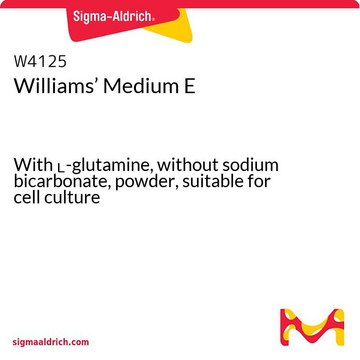Wszystkie zdjęcia(1)
Kluczowe dokumenty
N6635
Nutrient Mixture F-10 Ham
With L-glutamine, without sodium bicarbonate, powder, suitable for cell culture
Synonim(y):
Ham’s F-10
Zaloguj sięWyświetlanie cen organizacyjnych i kontraktowych
About This Item
Polecane produkty
Formularz
powder
metody
cell culture | mammalian: suitable
komponenty
HEPES: no
NaHCO3: no
sodium pyruvate: 0.11 g/L
L-glutamine: yes
phenol red: yes
Warunki transportu
ambient
temp. przechowywania
2-8°C
Szukasz podobnych produktów? Odwiedź Przewodnik dotyczący porównywania produktów
Opis ogólny
Nutrient Mixture F-10 Ham supports the clonal growth of a wide variety of cells like clones of Chinese hamster ovary [CHO] cells and a clone of HeLa and mouse L-cells. Ham′s F-10 has been developed to support the growth of human diploid cells, white blood cells for chromosomal analysis, and primary explants of rat, rabbit, and chicken tissues.
Zastosowanie
Nutrient Mixture F-10 Ham has been used:
- for the in vitro tissue culture from rabbit
- to culture satellite cells from fish white muscle of trout
- for culturing neonatal porcine islets (NPIs)
Ilość
Formulated to contain 9.8 grams of powder per liter of medium.
Rekonstytucja
Supplement with 1.2 g/L sodium bicarbonate.
Ta strona może zawierać tekst przetłumaczony maszynowo.
najczęściej kupowane z tym produktem
Numer produktu
Opis
Cennik
Hasło ostrzegawcze
Warning
Zwroty wskazujące rodzaj zagrożenia
Zwroty wskazujące środki ostrożności
Klasyfikacja zagrożeń
Skin Sens. 1
Kod klasy składowania
11 - Combustible Solids
Klasa zagrożenia wodnego (WGK)
WGK 2
Temperatura zapłonu (°F)
Not applicable
Temperatura zapłonu (°C)
Not applicable
Wybierz jedną z najnowszych wersji:
Masz już ten produkt?
Dokumenty związane z niedawno zakupionymi produktami zostały zamieszczone w Bibliotece dokumentów.
Klienci oglądali również te produkty
Z Bravo et al.
Reproduction in domestic animals = Zuchthygiene, 53(3), 629-635 (2018-02-24)
The follicular fluid exerts an effect on the sperm capacitation of several species; however, these effects vary according to species, both in the sperm motility and in the subsequent acrosome reaction. In this study, the effect of alpaca follicular fluid
Ensieh Sajadi et al.
Journal of cellular biochemistry, 120(10), 17312-17325 (2019-05-22)
The current study was conducted to assess the relationship between testicular cells in spermatogenesis, through which the production of healthy and mature sperm is essential. However, it seems necessary to obtain more information about the three-dimensional pattern of the testis
Katsusuke Hata et al.
The Journal of neuroscience : the official journal of the Society for Neuroscience, 38(2), 498-510 (2017-11-28)
The neural cell adhesion molecule (NCAM) is expressed both presynaptically and postsynaptically during neuromuscular junction formation. Genetic deletion in mice of all three isoforms (180, 140, and 120 kDa), or just the 180 isoform, suggested that different isoforms played distinct
Lu Yue et al.
STAR protocols, 1(3), 100128-100128 (2020-12-31)
Quiescent muscle stem cells, also called satellite cells (SCs), are essential for muscle regeneration. However, quiescent SCs are quickly activated during fluorescence-activated cell sorting (FACS) isolation. Here, we present an optimized protocol to isolate quiescent muscle stem cells from fixative-perfused
Cara E Ellis et al.
BioResearch open access, 4(1), 188-197 (2015-08-27)
Since the development of the Edmonton protocol, islet transplantation is increasingly encouraging as a treatment for type 1 diabetes. Strategies to ameliorate problems with the intraportal site include macroencapsulating the islets in diverse biomaterials. Characterization of these biomaterials is important
Protokoły
Powdered media and salt mixtures are extremely hygroscopic and should be protected from atmospheric moisture.
Nasz zespół naukowców ma doświadczenie we wszystkich obszarach badań, w tym w naukach przyrodniczych, materiałoznawstwie, syntezie chemicznej, chromatografii, analityce i wielu innych dziedzinach.
Skontaktuj się z zespołem ds. pomocy technicznej








